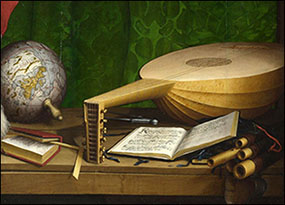|
|
|
|

Detail of Holbein's The Ambassadors, 1533.

Thomas Campion was born in London on February 12, 1567. He was a law student, a physician, a composer, a writer of masques, and a poet.
Campion's parents died when he was still a boy, but they left enough money to send him to Peterhouse College, Cambridge, in 1581.
He left Cambridge in 1584, apparently without taking a degree, and in 1586 was admitted to Gray's Inn in London to study law.
He participated in the Gray's Inn revels of 1588 and contributed songs to the Gesta Grayorum revels of 1594, but seems never to have been called to the bar.
Campion's first poetic attempts were in Latin. His love of quantitative versification in classical Latin poems carried over into his English poems and songs.
Campion was first published in 1591, when five of his songs appeared in Newman's unauthorized edition of Sidney's Astrophel and Stella. Four years
later he published his own book, a collection of Latin epigrams, called Poemata (1595). Campion's reputation
rests chiefly on his lyric poems, which are distinguished for their musical quality and charm. They were published 1601-1617 in four books of airs, beginning with
A Booke of Ayres to be Sung to the Lute, Orpherian and Bass Viol (1601).
In 1602 Campion, a theorist of prosody, published the prose work Observations in the Art of English Poesie, in which
he attacked “the vulgar and unartificial”, that is, inartistic, custom of rhyming. Campion's theories on poetry, which he himself rarely followed, were refuted by
Samuel Daniel in Defence of Rhyme (1603). Ben Jonson also stated that he had written
a discourse against both Campion and Daniel, but regrettably the text is lost to us.
Campion spent three years (1602-1605) on the Continent, and received the M.D. degree from the University of Caen in 1605. After returning to England, Campion
was practising as a doctor in London from 1606. During that time, he wrote several masques which were performed at the court of James I.
Perhaps the best of them was the Lords' Masque (1613). In 1613 he also published A New Way of Making Fowre Parts in Counterpoint,
a book on music theory. In 1615 Campion was questioned about the murder of , but was found innocent and released.
Campion died in London, probably of the plague, on March 1, 1620, and was buried at St. Dunstan's-in-the-West.
Percival Vivian wrote of Campion:
His early extravagances he outlived; and if it were possible to recall the time of his later years, we may imagine that we should find a kindly gentleman, full of ripe experience and judgment, yet cherishing the memories of old loves and friendships, and the generous illusions of youth ; devoted to the studies of poetry, music, and medicine, a true son of Apollo, as he was never tired of urging; clothed with that finer tact and sympathy which comes to a good physician.
(Works, xlix-l)1
- Vivian, Percival. "Introduction." Campion's Works. Percival Vivian, Ed.
Oxford: Oxford University Press, 1909.
Bibliography:
Davis, Walter R. Thomas Campion (1987)
Eldridge, Muriel T. Thomas Campion (1971)
Kastendieck, M. M. England's Musical Poet: Thomas Campion (1938)
Lindley, David. Thomas Campion (1997)
Lowbury, E., T. Salter, and A. Young. Thomas Campion: poet, composer, physician (1970)
Peltz, C. W. "Thomas Campion, An Elizabethan Neo-Classicist." MLQ 11 (1950), 3-6.
Short, R. W. "The Metrical Theory and Practice of Thomas Campion." MLA 59 (1944)
Vivian, Percival, ed. Campion's Works (Oxford, 1909)
Article Citation:
Jokinen, Anniina. "Life of Thomas Campion." Luminarium.
2 June 1996. [Date you accessed this article].
<http://www.luminarium.org/renlit/campbio.htm>
 | to Renaissance English Literature |
 | to Luminarium Encyclopedia |
Site copyright ©1996-2019 Anniina Jokinen. All Rights Reserved.
Created by Anniina Jokinen on June 2, 1996. Last updated on January 20, 2019.
|
|
The Tudors
King Henry VII
Elizabeth of York
King Henry VIII
Queen Catherine of Aragon
Queen Anne Boleyn
Queen Jane Seymour
Queen Anne of Cleves
Queen Catherine Howard
Queen Katherine Parr
King Edward VI
Queen Mary I
Queen Elizabeth I
Henry Fitzroy, Duke of Richmond
Renaissance English Writers
Bishop John Fisher
William Tyndale
Sir Thomas More
John Heywood
Thomas Sackville
Nicholas Udall
John Skelton
Sir Thomas Wyatt
Henry Howard
Hugh Latimer
Thomas Cranmer
Roger Ascham
Sir Thomas Hoby
John Foxe
George Gascoigne
John Lyly
Thomas Nashe
Sir Philip Sidney
Edmund Spenser
Richard Hooker
Robert Southwell
Robert Greene
George Peele
Thomas Kyd
Edward de Vere
Christopher Marlowe
Anthony Munday
Sir Walter Ralegh
Thomas Hariot
Thomas Campion
Mary Sidney Herbert
Sir John Davies
Samuel Daniel
Michael Drayton
Fulke Greville
Emilia Lanyer
William Shakespeare
Persons of Interest
Cardinal Thomas Wolsey
Archbishop Thomas Cranmer
Thomas Cromwell
John Fisher, Bishop of Rochester
Cardinal Lorenzo Campeggio
Cardinal Reginald Pole
Stephen Gardiner, Bishop of Winchester
William Tyndale
Pico della Mirandola
Desiderius Erasmus
Christopher Saint-German
Thomas Linacre
William Grocyn
Hugh Latimer
Elizabeth Barton, the Nun of Kent
For more, visit Encyclopedia
Historical Events
Field of the Cloth of Gold, 1520
Pilgrimage of Grace, 1536
The Babington Plot, 1586
The Spanish Armada, 1588
Government
Oath of Supremacy
The Act of Supremacy, 1534
The First Act of Succession, 1534
The Third Act of Succession, 1544
The Ten Articles, 1536
The Six Articles, 1539
The Second Statute of Repeal, 1555
Images of London:
London in the time of Henry VII. MS. Roy. 16 F. ii.
London, 1510, earliest view in print
Map of England from Saxton's Descriptio Angliae, 1579
Location Map of Elizabethan London
Plan of the Bankside, Southwark, in Shakespeare's time
Detail of Norden's Map of the Bankside, 1593
Bull and Bear Baiting Rings from the Agas Map (1569-1590, pub. 1631)
Sketch of the Swan Theatre, c. 1596
Westminster in the Seventeenth Century, by Hollar
Visscher's Panoramic View of London, 1616. COLOR
For more, visit Encyclopedia
|
|